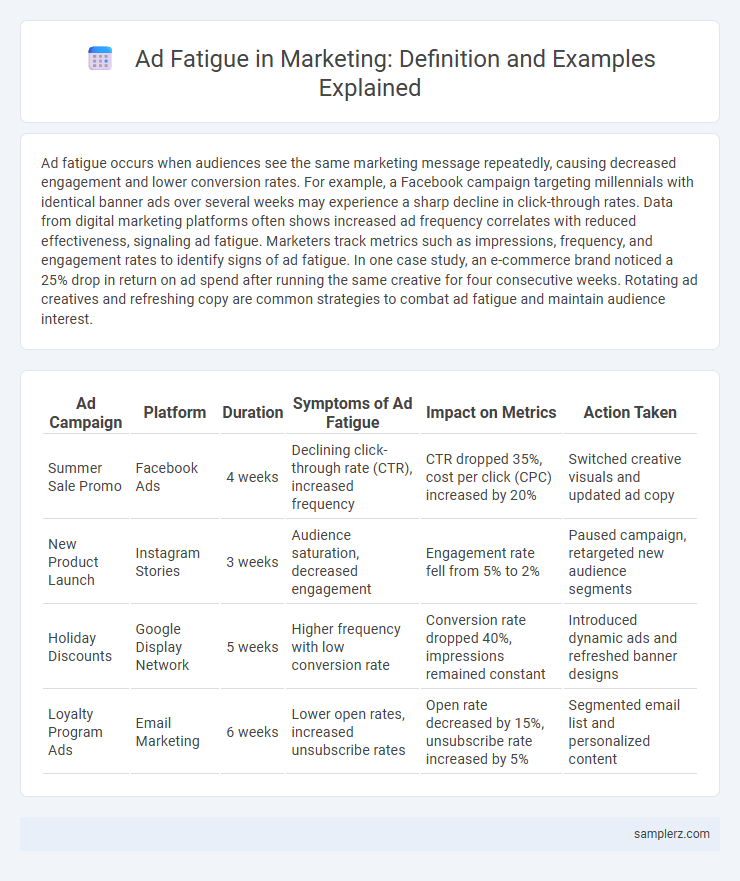Ad fatigue occurs when audiences see the same marketing message repeatedly, causing decreased engagement and lower conversion rates. For example, a Facebook campaign targeting millennials with identical banner ads over several weeks may experience a sharp decline in click-through rates. Data from digital marketing platforms often shows increased ad frequency correlates with reduced effectiveness, signaling ad fatigue. Marketers track metrics such as impressions, frequency, and engagement rates to identify signs of ad fatigue. In one case study, an e-commerce brand noticed a 25% drop in return on ad spend after running the same creative for four consecutive weeks. Rotating ad creatives and refreshing copy are common strategies to combat ad fatigue and maintain audience interest.
Table of Comparison
| Ad Campaign | Platform | Duration | Symptoms of Ad Fatigue | Impact on Metrics | Action Taken |
|---|---|---|---|---|---|
| Summer Sale Promo | Facebook Ads | 4 weeks | Declining click-through rate (CTR), increased frequency | CTR dropped 35%, cost per click (CPC) increased by 20% | Switched creative visuals and updated ad copy |
| New Product Launch | Instagram Stories | 3 weeks | Audience saturation, decreased engagement | Engagement rate fell from 5% to 2% | Paused campaign, retargeted new audience segments |
| Holiday Discounts | Google Display Network | 5 weeks | Higher frequency with low conversion rate | Conversion rate dropped 40%, impressions remained constant | Introduced dynamic ads and refreshed banner designs |
| Loyalty Program Ads | Email Marketing | 6 weeks | Lower open rates, increased unsubscribe rates | Open rate decreased by 15%, unsubscribe rate increased by 5% | Segmented email list and personalized content |
Understanding Ad Fatigue in Modern Marketing
Ad fatigue occurs when target audiences become overly exposed to the same advertisement, leading to decreased engagement and conversion rates. Metrics such as click-through rate (CTR) decline and increased cost per acquisition (CPA) signal the onset of ad fatigue in digital campaigns. Effective strategies to combat ad fatigue include rotating creatives, segmenting audiences, and leveraging frequency caps to maintain campaign performance.
Common Signs of Ad Fatigue in Campaigns
Common signs of ad fatigue in marketing campaigns include a significant drop in click-through rates (CTR) and increased cost per click (CPC), indicating audience disengagement. When impressions remain steady but conversions decline, it signals the target market is overexposed to the same creative or message. Additionally, rising negative feedback such as unfollows or ad hides on platforms like Facebook and Instagram often points to consumers' diminishing interest and ad wear-out.
Real-World Examples of Ad Fatigue
Brands like Coca-Cola experienced ad fatigue during extended holiday campaigns, leading to decreased engagement and lower click-through rates. Facebook's algorithm adjustments highlight how repetitive ads in the same audience can increase frequency but reduce conversion rates. In e-commerce, Amazon noticed that static product ads sent repeatedly to the same customers caused a decline in ROI, prompting the adoption of fresh creatives and targeted rotations.
Case Study: Ad Fatigue on Social Media Platforms
A notable case study of ad fatigue on social media platforms is demonstrated by a global retail brand that experienced a 30% drop in click-through rates after running the same Facebook ads for four consecutive weeks. The campaign's frequency peaked at 6 impressions per user, leading to decreased engagement and increased negative feedback. These metrics highlight the critical need for creative rotation and audience segmentation to sustain ad performance.
How Ad Fatigue Impacts Audience Engagement
Ad fatigue in marketing occurs when audiences see the same advertisement repeatedly, leading to decreased attention and reduced click-through rates. This overexposure causes viewers to become disengaged, negatively impacting brand recall and conversion rates. Marketers must monitor frequency metrics closely to optimize campaign performance and maintain audience interest.
Measuring Ad Fatigue with Analytics
Measuring ad fatigue in marketing relies heavily on analytics tools that track key metrics such as click-through rates (CTR), conversion rates, and engagement levels over time. Declining CTR and increased ad frequency without corresponding conversions indicate audience saturation, signaling the onset of ad fatigue. Advanced analytics platforms leverage real-time data to optimize campaign refresh rates, ensuring ads remain effective and relevant to target demographics.
Ad Fatigue in Email Marketing Campaigns
Email marketing campaigns often suffer from ad fatigue when recipients repeatedly receive the same promotional content, leading to decreased open rates and engagement. Monitoring metrics like click-through rates and unsubscribe rates helps identify when audience interest wanes, signaling the need for fresh creative or segmented targeting. Implementing A/B testing and personalized content strategies can effectively combat ad fatigue and maintain campaign effectiveness.
Creative vs. Repetitive: Ad Variations That Prevent Fatigue
Creating diverse ad variations with unique visuals, headlines, and messages significantly reduces ad fatigue by keeping the audience engaged. Using repetitive ad creatives leads to diminished click-through rates and increased ad blindness, negatively affecting campaign performance. Implementing a strategy that regularly rotates fresh creative assets maintains user interest and enhances overall marketing ROI.
Lessons Learned from Famous Ad Fatigue Failures
Samsung's Galaxy Note 7 marketing campaign faced ad fatigue as repeated exposure to faulty product promotions led to consumer distrust and declining engagement. The campaign highlighted the critical lesson that overuse of a single creative concept without refreshing content can diminish ROI and brand reputation. Marketers must monitor audience response metrics closely and diversify messaging to sustain interest and prevent fatigue.
Strategies to Overcome Ad Fatigue in Marketing
Rotating ad creatives regularly can effectively combat ad fatigue by keeping content fresh and engaging for target audiences. Implementing frequency caps limits the number of times a user sees the same ad, reducing annoyance and maintaining interest. Leveraging audience segmentation ensures ads are tailored to specific demographics, increasing relevance and minimizing the risk of viewers becoming disengaged.

example of ad fatigue in marketing Infographic
 samplerz.com
samplerz.com